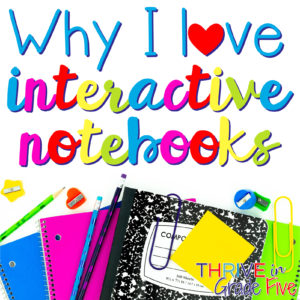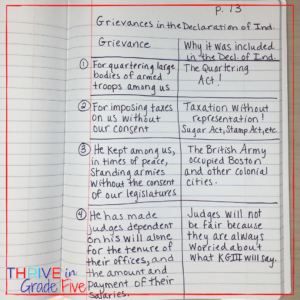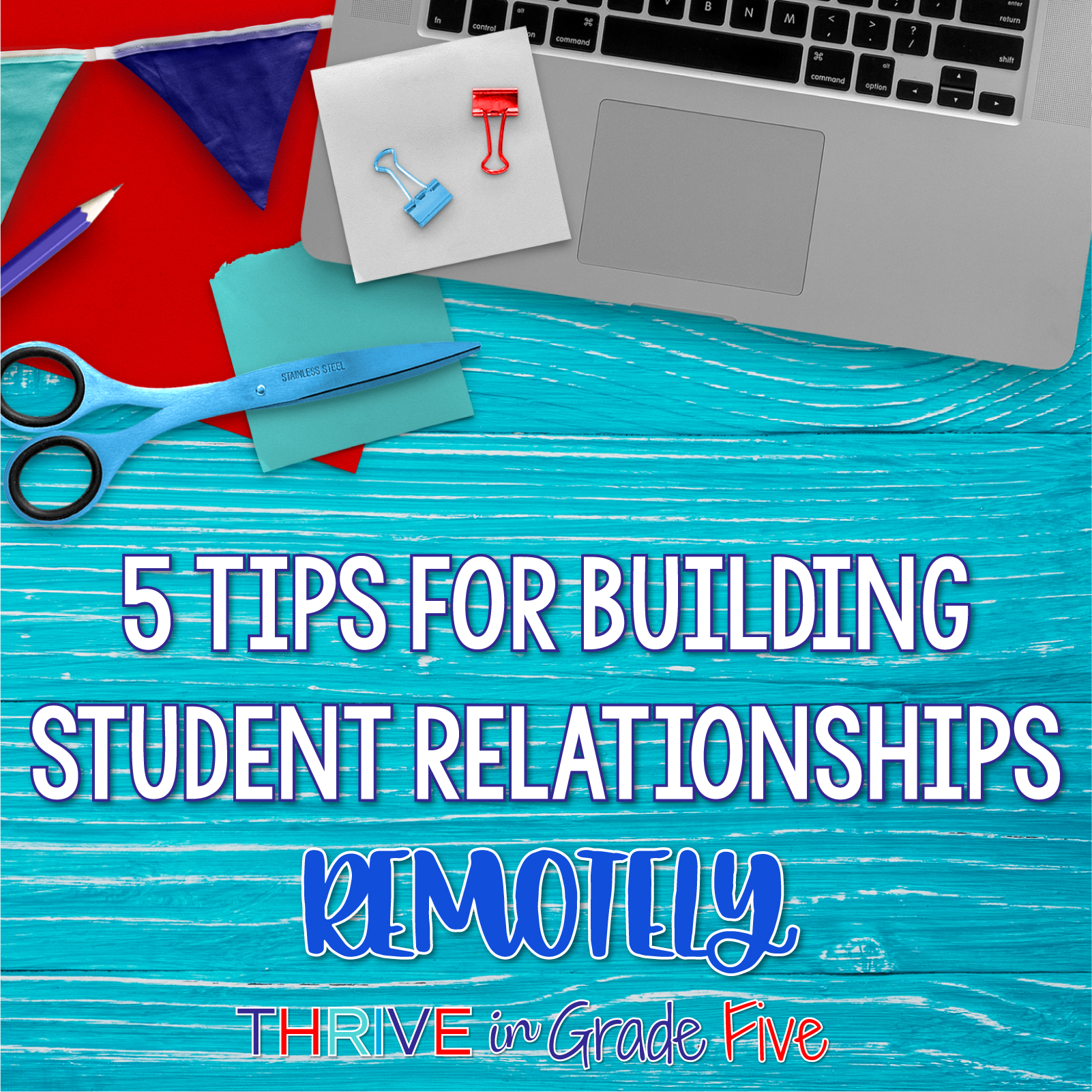When I discovered interactive notebooks a few years ago, I knew I’d found a goldmine!
I finally had a place for students to keep notes, add fun foldable activities, and more.
I always say that time spent working on interactive notebooks is never wasted because these amazing little books serve as a year-long reference point.
Throughout the school year, my students’ notebooks become living, interactive textbooks.

Why I LOVE Interactive Notebooks
Interactive notebooks can be used for any subject, but I especially love using them during my social studies and writing classes.
Interactive notebooks allow my students to keep all of the “important stuff” together. No more loose papers crammed into a folder. Woohoo!
These notebooks provide the perfect place for my students to record their learning, take notes, glue foldable pieces, analyze vocabulary, and more.
Because (most of) my upper elementary students struggle with organization, we use their interactive notebooks as their ONE place to keep everything needed to be successful during class.
Working daily (or almost daily) in students’ notebooks helps to create a living document that encourages ownership and provides a year-long reference point.

What is an interactive notebook?
Now that you know why I love using interactive notebooks, let’s talk about what you should look for before deciding on the notebooks you will use with students.
I highly recommend using composition notebooks with upper elementary students.
Composition notebooks are an excellent choice for students’ interactive notebooks because the pages are sewn in and a person really has to work to pull them out.
If you choose spiral notebooks for your students, they’ll give you a little more space per page but you’ll be battling lost pages all year.
We’ve used college ruled and wide ruled composition notebooks and both work just fine.
You can find composition notebooks at your local store or check out the ones linked here: Composition Notebooks

How to Set Up Interactive Notebooks
Table of Contents & Page Numbers
The very first thing we do when setting up our interactive notebooks is to create a table of contents.
I recommend using the first four pages of the notebook as the table of contents.
The table of contents is simple to set up. We make a chart with page numbers and what’s on each page. Check out the picture below to see an example.
We add a lot of assignments during the year, so we will need all of the first four pages.
If you don’t set up the table of contents first, students will quickly fill those pages with assignments and then they won’t have anywhere to list the contents of their notebooks.
Once we have a table of contents set up, I do have students number the first 25 pages or so just to get them started. They will learn to continue numbering the pages as we go throughout the year.

Establish Procedures for Adding to Interactive Notebooks
Think ahead to how you want students’ interactive notebooks to look and function.
Do you want to be more hands-on with students while they’re working in their notebooks or do you want them to work independently?
Establish those procedures at the very beginning of the school year.
During the first few years that I used interactive notebooks, I had students use glue sticks. Unfortunately, I soon found out that papers added using glue sticks fell out after a month or two.
You’ll find that liquid glue is a much better option for your students’ notebooks.
At first, students will try to use giant globs of glue in their notebooks. You must remind them that all of their pages will stick together and glue will ooze out if they use too much liquid glue.
I tell my students they may use two tiny dots of glue for a smaller foldable activity and four tiny dots of glue for a large foldable template.
Also, we have a chant that I do with students when they are starting to use too much glue. “A little bit of glue goes a long, long way!”
Envelopes for Extra Pieces
Sometimes we are working so diligently in our interactive notebooks and *poof,* we’re suddenly out of time.
It is so frustrating to run out of class time when working in interactive notebooks and collecting the unfinished foldable pieces to glue in next class takes too much time.
I found that these fantastic little envelopes save my sanity big time!
At the beginning of the school year, we add 6 inch by 9 inch envelopes (with clasps) to the backs of our notebooks. These envelopes fit perfectly and eliminate the frustration of losing pieces from one class period to the next.


Ideas for Using Interactive Notebooks
Truly, there are endless ideas for using interactive notebooks.
I’m so excited to share my favorite ideas with you!
Vocabulary Charts
Vocabulary charts are simple to add to notebooks and they give students a place to analyze and think about the new vocabulary word.
Divide one entire page into four sections.
- Write the word at the top of the page.
- In one box, write the dictionary or textbook definition of the word.
- In another box, students will write a definition using their own words.
- In the next box, students will write the word in an original sentence and write one or two synonyms for the word.
- Finally, students will use the remaining box to create a sketch showing the meaning of the word.
Taking Notes
As upper elementary teachers, we should be guiding students’ notes.
It’s not fair to lecture 5th graders and expect them to take notes on important points.
Interactive notebooks are the perfect place to guide your students’ notes.
I project my interactive notebook on the technology board using a document camera. Then, we write notes together on important events, concepts, historical people, and etc.
Doing the notes together ensures that the information will always be in their notebooks for reference.

Foldable Templates
Foldable activities are so much fun!
These templates allow students to fill in information, cut/fold in a fun way, and glue into their notebooks for future reference.
The vast majority of my social studies resources include interactive notebook foldable templates, like this one: Lost Colony of Roanoke – Interactive Notebook Lesson

Journal Entries
I ask students to use a page in their interactive notebooks to write about what they’ve learned during the week.
Students enjoy this weekly habit because they can look back throughout the year to see how much they’ve learned and grown.
Planning Projects
Interactive notebooks provide a great place for students to plan projects.
In addition to thinking and planning in their notebooks, students can refer to previous pages as an informational reference.
They’ll have their plans conveniently with them while completing projects.

Management and Grading of Interactive Notebooks
Storage
I rarely, if ever, let students take interactive notebooks home.
They end up not bringing them back or dogs/siblings destroy them.
The notebooks are valuable, so we keep them at school.
I have one bookshelf per class and a couple of kids pass out the notebooks out at beginning of class.
This process takes less than two minutes because I’ve already established the procedure of turning in notebooks by table/row.
Grading
Grading interactive notebooks can take over your life if you let it.
DON’T take notebooks home – It’s too much to carry and pieces fall out.
Here’s what I do to grade students’ interactive notebooks:
I walk around while students are working to monitor and look at their work.
I usually do more formal grading once per quarter – but even then, it’s more of an overview.
I don’t check every page because I’ve been monitoring as we go.
I use a half-page rubric to grade and I’d love to share it with you.
Students glue this rubric into their notebooks along with a self-reflection on their work.
This rubric is editable in PowerPoint format. Simply enter your first name and email address to have the editable rubric sent to you right away!

If you’d like to keep this blog post for later, simply save this image to your teacher Pinterest board!
* Please note that Thrive in Grade Five (Jenifer Bazzit) is a participant in the Amazon Services LLC Associates Program, an affiliate advertising program designed to provide a means for sites to earn advertising fees by advertising and linking to amazon.com. *
Need help planning and implementing your social studies content? I can help!









12 Comments
I’ve used interactive notebooks for the last two years, and the biggest struggle I have is getting new students to set up their notebooks when they arrive. We have spiraling standards, so we often look back in our notebooks at past notes, and new kids never have those. Any advice for how to help new students transition into these notebooks?
Yes, Emily, that is such a struggle! I have new students just start their notebooks from where we are when they join the class. I hope this helps!
If you are spiraling back to previous notes, Do you write in your own book to model the note-taking? If you do, would it be possible for you to copy the necessary pages from your book and tape into the proper areas of the student book? Then they can pick up from where you are currently using the INB. I f you are not keeping a book of your own, could you choose the book of a responsible student to make the copies from for the new student?
Hi! I do show my notebook on the smartboard while I write in it and place foldables. I could definitely copy the pages, especially text-heavy ones, and tape them into students’ notebooks. I do like using responsible students’ notebooks as examples for students who missed.
Thank you. I love reading what you have to say, and I have learned so much from you!
Thank you for this kind comment, Sarah! I’m so glad I was able to help 🙂
Hi! Thank you for this great post! I am going into my 3rd year of teaching Social Studies. The teacher before me did a great job implementing interactive notebooks, and I am still struggling to figure out what works and what doesn’t.
The last couple of years I have switched between guided notes and interactive foldable pieces in notebooks. I’m finding this can be overwhelming when it comes to studying because of there being so many different sources of information to keep track of. I believe the notebooks would streamline this.
I think one of my first big questions that always makes me hesitant to do the notebooks is time. Do you assign the cutting for homework? (pieces might get lost) Do you just use class time to do so? If so, typically how long does it take for the pieces to be cut and glued? Would pre-set up be worthwhile – such as taking a day and cutting and gluing the lesson/chapter/unit pieces down first before instruction begins?
That turned into many questions! Thank you for any insight you have and are willing to share 🙂
Hi Meredith! I get to where we are much faster at cutting and pasting. We work on improving our cutting procedures and processes. It takes only a minute or two once we get into the year and students learn my procedures. I think that a pre-set up time period would be awesome. I’ve never done that but that’s an awesome idea!
Love the envelope in the back idea!!! Brilliant and simple!! Another GENIUS idea I saw a while ago was to have the left side of the open notebook be the TEACH side – where teacher models and gives explicit info/facts/ strategies/short text …whatever! and on the right side the students do some APPLY/PRACTICE/RESPOND type work… this promotes interacting with the notes from the Teacher side, not just copying what the teacher did!!!! (I have seen it where the sides are the opposite but makes more sense for the teacher side to be on the left and the student side be on the right since we read/write in that L to R direction!)
HELP! I have tried doing a Table of Contents…Any suggestions besides page by page??? It always starts out right then gets frustrating for everyone especially me!
Thank you for sharing that idea, Marie! I love it! The table of contents seems to get hairy as we go through the year. What I do is to reserve the first five pages of the notebooks for the table of contents.
Hi! First year teacher here! Starting in Fifth grade. Love the idea of interactive notebooks. Do your students have more than one interactive notebook? You said you like using them for SS and writing – do your students have two separate notebooks? Would you recommend having possibly 3 – math, reading/writing, social studies? Thanks!
Hi Cristina! Great question 🙂 Yes, my students have separate interactive notebooks for both social studies and writing. They are able to stay MUCH more organized when we only have one notebook per subject! I hope this helps!